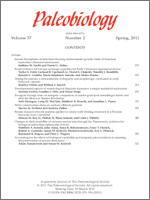Niche conservatism is increasingly recognized in diverse modern ecological settings, and it influences many aspects of modern ecosystems, including speciation mechanisms, community structure, and response to climate change. Here, we investigate the stability of niches with benthic marine invertebrates along a Late Ordovician onshore-offshore gradient on the Cincinnati Arch in the eastern United States. Using a Gaussian niche model characterized by peak abundance, preferred environment, and environmental tolerance, with these parameters estimated through weighted averaging and logistic regression, we find evidence of strong niche conservatism in peak abundance and preferred environment, particularly for abundant taxa. This conservatism is maintained in successive depositional sequences and through the nearly 9–10 Myr study interval. Environmental tolerance shows no evidence of conservatism, although numerical simulations suggest that the error rates in estimates of this parameter are so high that they could overwhelm evidence of conservatism. These numerical simulations also indicate that both weighted averaging and logistic regression produce useful estimates of peak abundance and preferred environment, with slightly better results for weighted averaging. This evidence for niche conservatism suggests that long-term shifts of higher taxa of marine invertebrates into deeper water are primarily the result of differential rates of origination and extinction. These results also add to the evidence of long periods of relatively stable ecosystems despite regional environmental perturbations, and they constrain the causes of peaked patterns in occupancy.
How to translate text using browser tools
1 March 2011
Niche conservatism along an onshore-offshore gradient
Steven M Holland,
Andrew Zaffos
ACCESS THE FULL ARTICLE

Paleobiology
Vol. 37 • No. 2
Spring 2011
Vol. 37 • No. 2
Spring 2011




